Management Decision Making for Managers: Tesco, UK Case Study
VerifiedAdded on 2022/12/27
|19
|4948
|63
Case Study
AI Summary
This case study examines the decision-making processes at Tesco, UK, focusing on the application of management theories and practical strategies within the retail giant. It delves into Tesco's organizational structure, mission, and values, particularly how these elements shape its decision-making approach. The study explores the decision-making process at various levels within Tesco, including the use of information systems, hierarchical structures, and the integration of ethical considerations. It further investigates the role of cognitive biases, bounded rationality, and the impact of these factors on managerial decisions. The analysis includes a discussion of the Tesco Clubcard and its influence on customer loyalty. Theoretical concepts are explored, including ethics, meta-ethics, and the application of heuristics in decision-making. The study critically reflects on the strengths and weaknesses of Tesco's decision-making methods, proposing improvements for enhancing ethical practices and fostering trust among stakeholders. Finally, the study provides a conclusion that summarizes the key findings and implications of the analysis.

Running head: MANAGEMENT
Decision making for managers: A case study of Tesco, UK
Name of the student:
Name of the university:
Author note:
Decision making for managers: A case study of Tesco, UK
Name of the student:
Name of the university:
Author note:
Paraphrase This Document
Need a fresh take? Get an instant paraphrase of this document with our AI Paraphraser
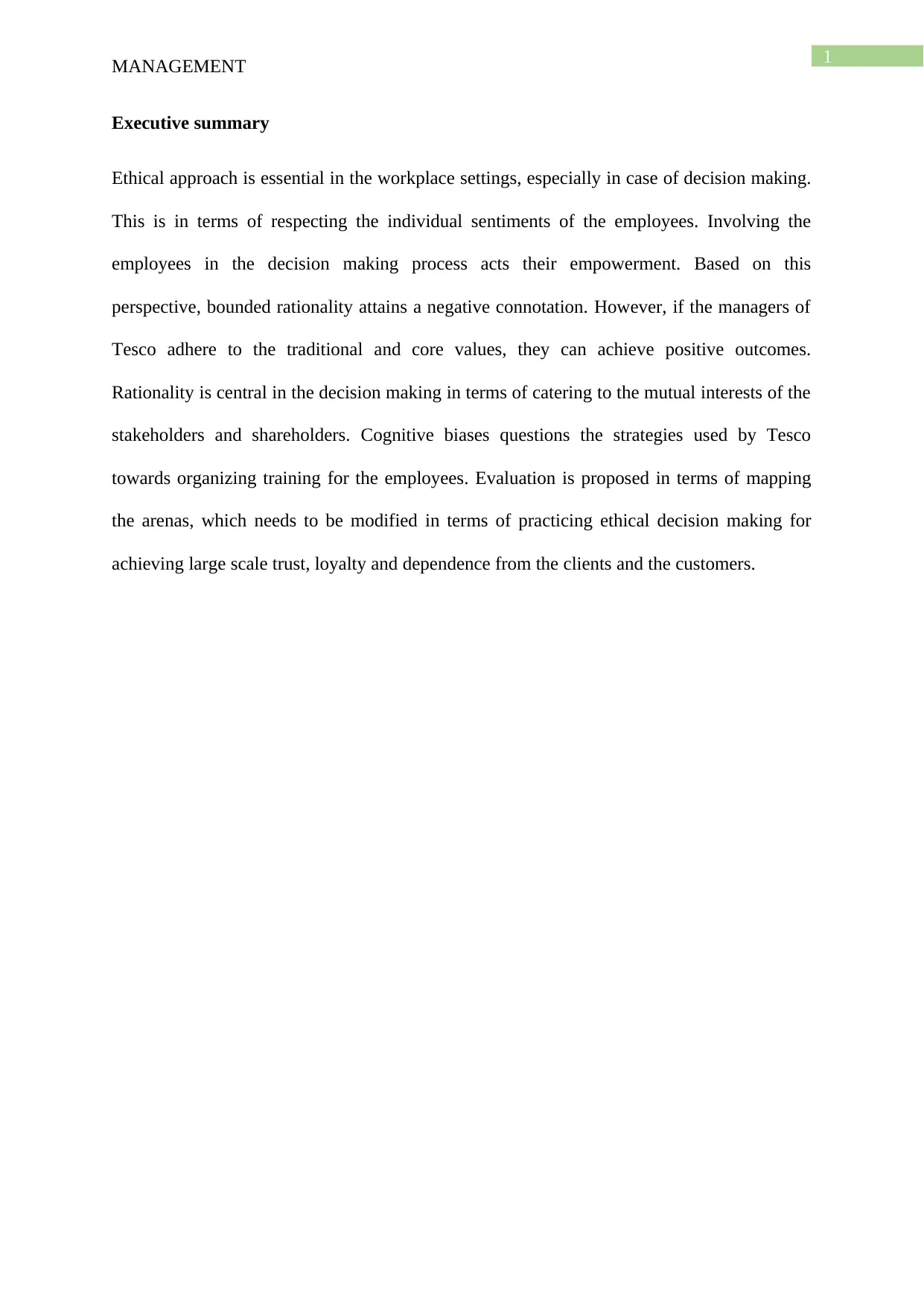
1
MANAGEMENT
Executive summary
Ethical approach is essential in the workplace settings, especially in case of decision making.
This is in terms of respecting the individual sentiments of the employees. Involving the
employees in the decision making process acts their empowerment. Based on this
perspective, bounded rationality attains a negative connotation. However, if the managers of
Tesco adhere to the traditional and core values, they can achieve positive outcomes.
Rationality is central in the decision making in terms of catering to the mutual interests of the
stakeholders and shareholders. Cognitive biases questions the strategies used by Tesco
towards organizing training for the employees. Evaluation is proposed in terms of mapping
the arenas, which needs to be modified in terms of practicing ethical decision making for
achieving large scale trust, loyalty and dependence from the clients and the customers.
MANAGEMENT
Executive summary
Ethical approach is essential in the workplace settings, especially in case of decision making.
This is in terms of respecting the individual sentiments of the employees. Involving the
employees in the decision making process acts their empowerment. Based on this
perspective, bounded rationality attains a negative connotation. However, if the managers of
Tesco adhere to the traditional and core values, they can achieve positive outcomes.
Rationality is central in the decision making in terms of catering to the mutual interests of the
stakeholders and shareholders. Cognitive biases questions the strategies used by Tesco
towards organizing training for the employees. Evaluation is proposed in terms of mapping
the arenas, which needs to be modified in terms of practicing ethical decision making for
achieving large scale trust, loyalty and dependence from the clients and the customers.
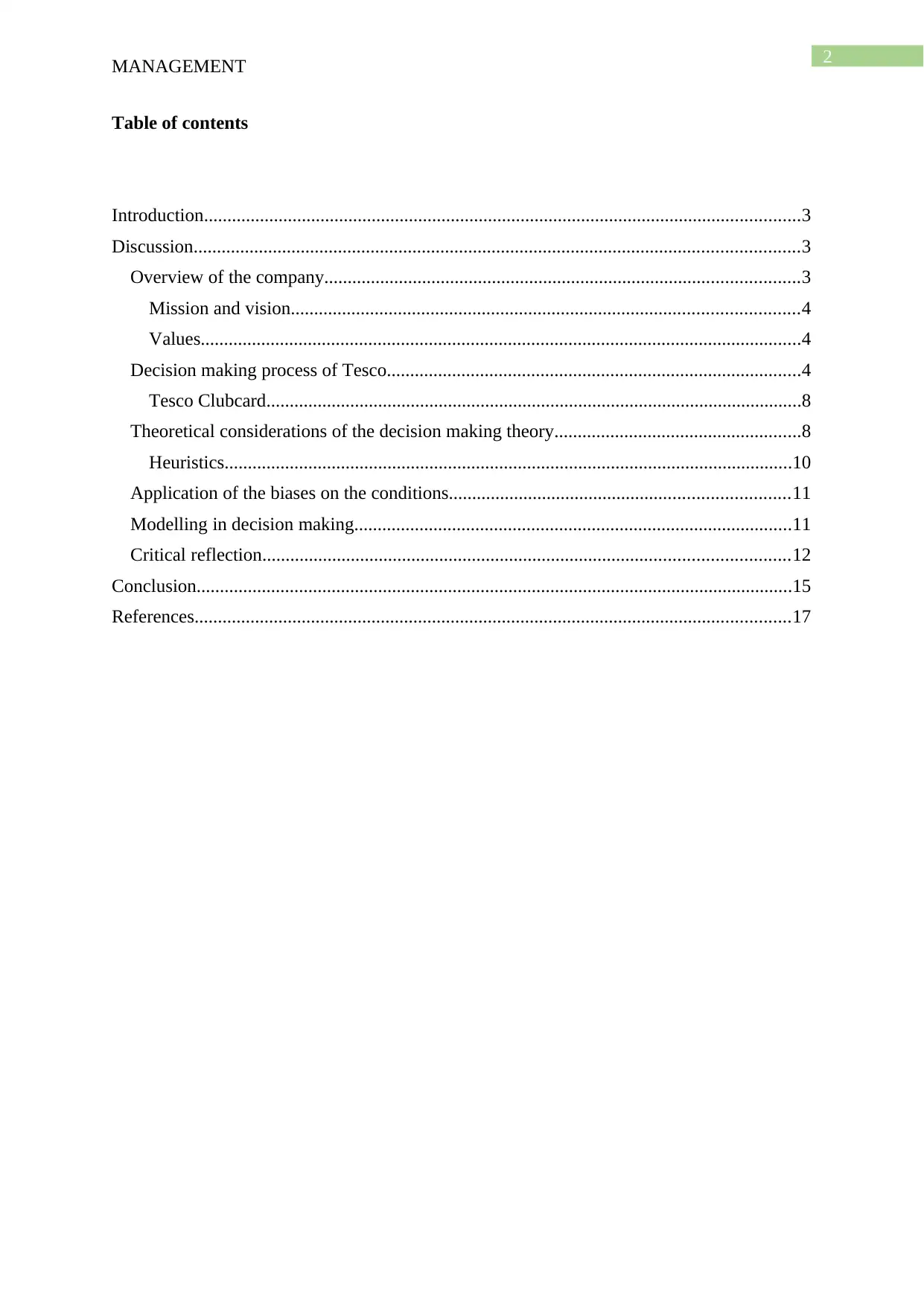
2
MANAGEMENT
Table of contents
Introduction................................................................................................................................3
Discussion..................................................................................................................................3
Overview of the company......................................................................................................3
Mission and vision.............................................................................................................4
Values.................................................................................................................................4
Decision making process of Tesco.........................................................................................4
Tesco Clubcard...................................................................................................................8
Theoretical considerations of the decision making theory.....................................................8
Heuristics..........................................................................................................................10
Application of the biases on the conditions.........................................................................11
Modelling in decision making..............................................................................................11
Critical reflection.................................................................................................................12
Conclusion................................................................................................................................15
References................................................................................................................................17
MANAGEMENT
Table of contents
Introduction................................................................................................................................3
Discussion..................................................................................................................................3
Overview of the company......................................................................................................3
Mission and vision.............................................................................................................4
Values.................................................................................................................................4
Decision making process of Tesco.........................................................................................4
Tesco Clubcard...................................................................................................................8
Theoretical considerations of the decision making theory.....................................................8
Heuristics..........................................................................................................................10
Application of the biases on the conditions.........................................................................11
Modelling in decision making..............................................................................................11
Critical reflection.................................................................................................................12
Conclusion................................................................................................................................15
References................................................................................................................................17
⊘ This is a preview!⊘
Do you want full access?
Subscribe today to unlock all pages.

Trusted by 1+ million students worldwide
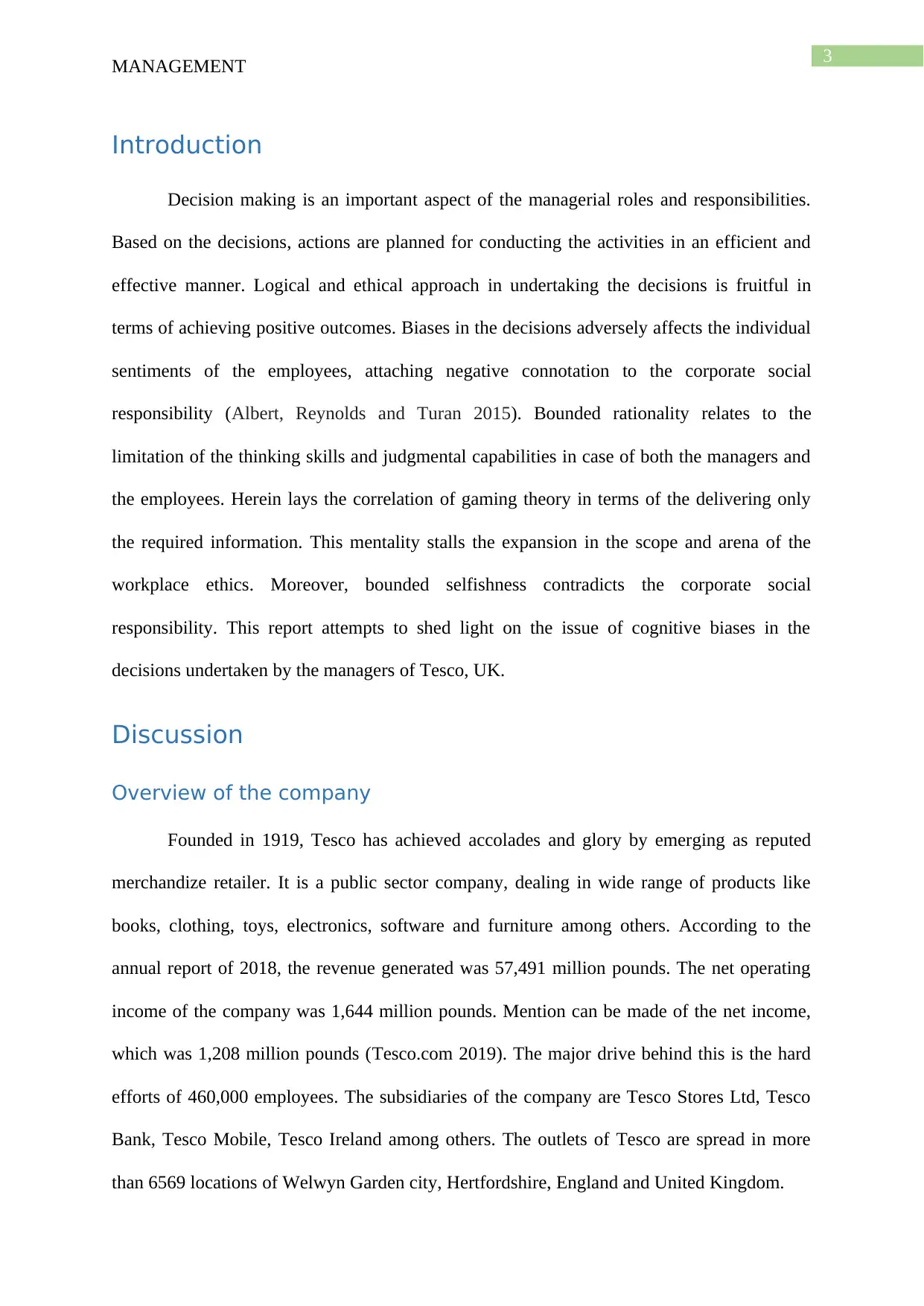
3
MANAGEMENT
Introduction
Decision making is an important aspect of the managerial roles and responsibilities.
Based on the decisions, actions are planned for conducting the activities in an efficient and
effective manner. Logical and ethical approach in undertaking the decisions is fruitful in
terms of achieving positive outcomes. Biases in the decisions adversely affects the individual
sentiments of the employees, attaching negative connotation to the corporate social
responsibility (Albert, Reynolds and Turan 2015). Bounded rationality relates to the
limitation of the thinking skills and judgmental capabilities in case of both the managers and
the employees. Herein lays the correlation of gaming theory in terms of the delivering only
the required information. This mentality stalls the expansion in the scope and arena of the
workplace ethics. Moreover, bounded selfishness contradicts the corporate social
responsibility. This report attempts to shed light on the issue of cognitive biases in the
decisions undertaken by the managers of Tesco, UK.
Discussion
Overview of the company
Founded in 1919, Tesco has achieved accolades and glory by emerging as reputed
merchandize retailer. It is a public sector company, dealing in wide range of products like
books, clothing, toys, electronics, software and furniture among others. According to the
annual report of 2018, the revenue generated was 57,491 million pounds. The net operating
income of the company was 1,644 million pounds. Mention can be made of the net income,
which was 1,208 million pounds (Tesco.com 2019). The major drive behind this is the hard
efforts of 460,000 employees. The subsidiaries of the company are Tesco Stores Ltd, Tesco
Bank, Tesco Mobile, Tesco Ireland among others. The outlets of Tesco are spread in more
than 6569 locations of Welwyn Garden city, Hertfordshire, England and United Kingdom.
MANAGEMENT
Introduction
Decision making is an important aspect of the managerial roles and responsibilities.
Based on the decisions, actions are planned for conducting the activities in an efficient and
effective manner. Logical and ethical approach in undertaking the decisions is fruitful in
terms of achieving positive outcomes. Biases in the decisions adversely affects the individual
sentiments of the employees, attaching negative connotation to the corporate social
responsibility (Albert, Reynolds and Turan 2015). Bounded rationality relates to the
limitation of the thinking skills and judgmental capabilities in case of both the managers and
the employees. Herein lays the correlation of gaming theory in terms of the delivering only
the required information. This mentality stalls the expansion in the scope and arena of the
workplace ethics. Moreover, bounded selfishness contradicts the corporate social
responsibility. This report attempts to shed light on the issue of cognitive biases in the
decisions undertaken by the managers of Tesco, UK.
Discussion
Overview of the company
Founded in 1919, Tesco has achieved accolades and glory by emerging as reputed
merchandize retailer. It is a public sector company, dealing in wide range of products like
books, clothing, toys, electronics, software and furniture among others. According to the
annual report of 2018, the revenue generated was 57,491 million pounds. The net operating
income of the company was 1,644 million pounds. Mention can be made of the net income,
which was 1,208 million pounds (Tesco.com 2019). The major drive behind this is the hard
efforts of 460,000 employees. The subsidiaries of the company are Tesco Stores Ltd, Tesco
Bank, Tesco Mobile, Tesco Ireland among others. The outlets of Tesco are spread in more
than 6569 locations of Welwyn Garden city, Hertfordshire, England and United Kingdom.
Paraphrase This Document
Need a fresh take? Get an instant paraphrase of this document with our AI Paraphraser
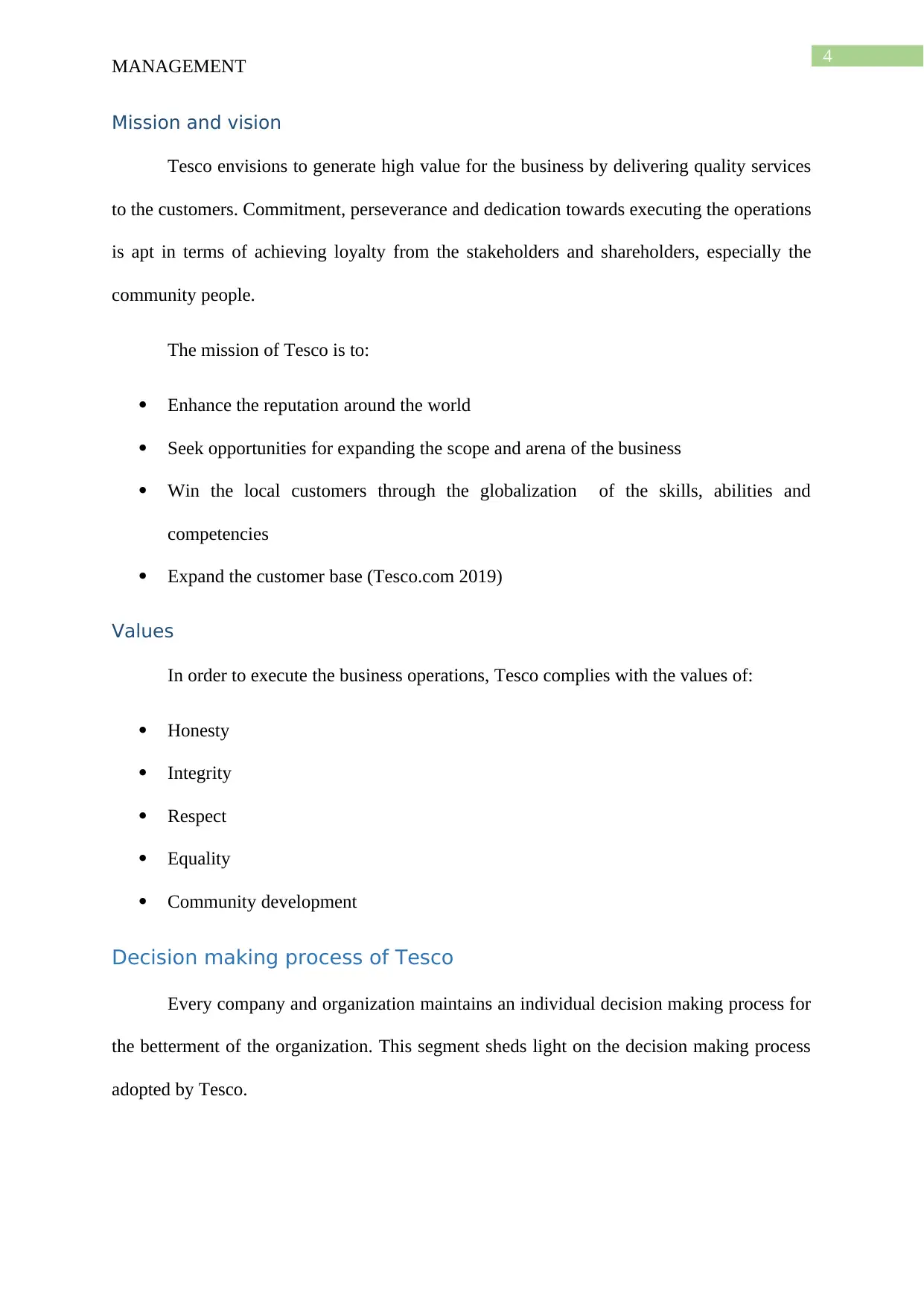
4
MANAGEMENT
Mission and vision
Tesco envisions to generate high value for the business by delivering quality services
to the customers. Commitment, perseverance and dedication towards executing the operations
is apt in terms of achieving loyalty from the stakeholders and shareholders, especially the
community people.
The mission of Tesco is to:
Enhance the reputation around the world
Seek opportunities for expanding the scope and arena of the business
Win the local customers through the globalization of the skills, abilities and
competencies
Expand the customer base (Tesco.com 2019)
Values
In order to execute the business operations, Tesco complies with the values of:
Honesty
Integrity
Respect
Equality
Community development
Decision making process of Tesco
Every company and organization maintains an individual decision making process for
the betterment of the organization. This segment sheds light on the decision making process
adopted by Tesco.
MANAGEMENT
Mission and vision
Tesco envisions to generate high value for the business by delivering quality services
to the customers. Commitment, perseverance and dedication towards executing the operations
is apt in terms of achieving loyalty from the stakeholders and shareholders, especially the
community people.
The mission of Tesco is to:
Enhance the reputation around the world
Seek opportunities for expanding the scope and arena of the business
Win the local customers through the globalization of the skills, abilities and
competencies
Expand the customer base (Tesco.com 2019)
Values
In order to execute the business operations, Tesco complies with the values of:
Honesty
Integrity
Respect
Equality
Community development
Decision making process of Tesco
Every company and organization maintains an individual decision making process for
the betterment of the organization. This segment sheds light on the decision making process
adopted by Tesco.
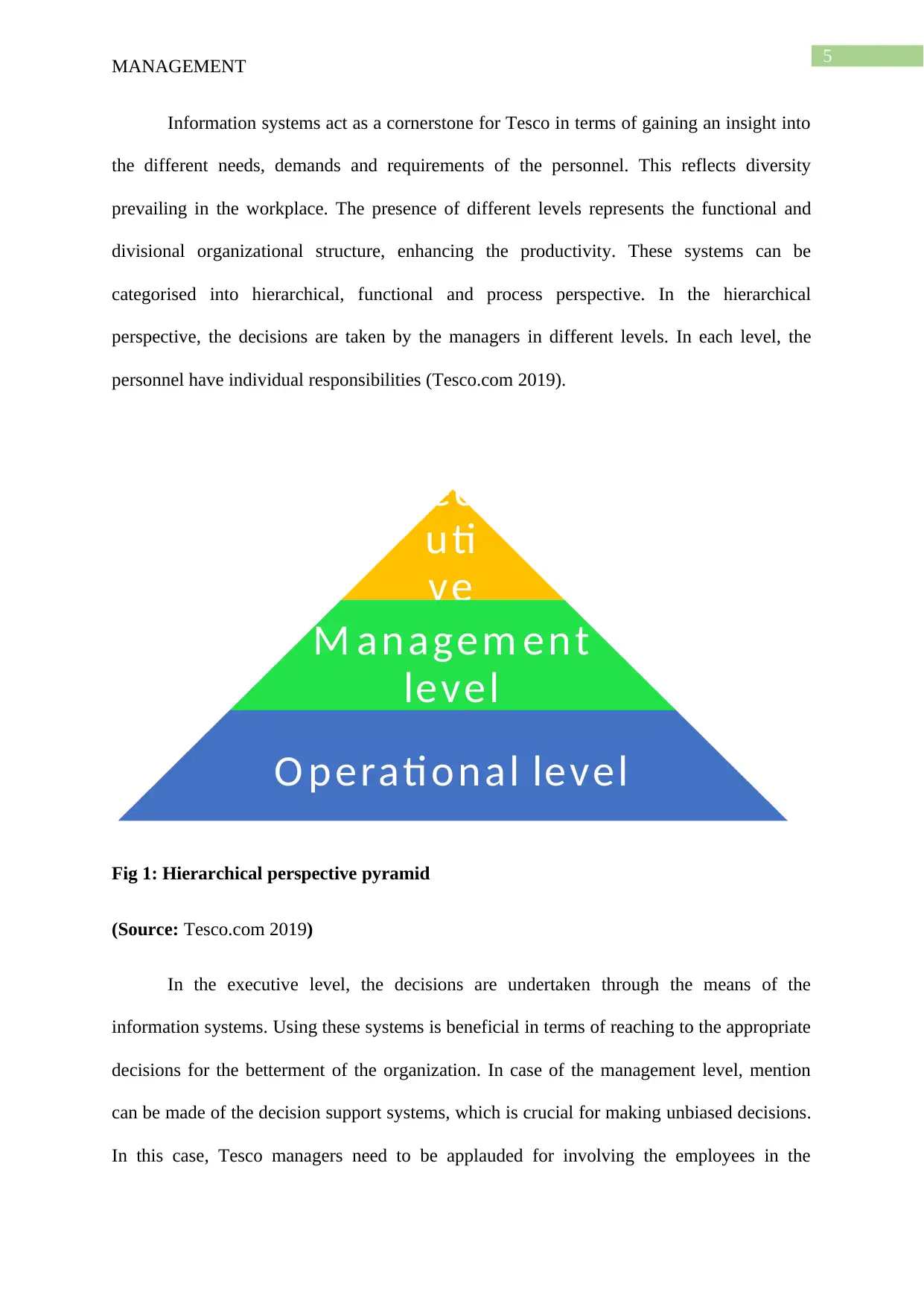
5
MANAGEMENT
Information systems act as a cornerstone for Tesco in terms of gaining an insight into
the different needs, demands and requirements of the personnel. This reflects diversity
prevailing in the workplace. The presence of different levels represents the functional and
divisional organizational structure, enhancing the productivity. These systems can be
categorised into hierarchical, functional and process perspective. In the hierarchical
perspective, the decisions are taken by the managers in different levels. In each level, the
personnel have individual responsibilities (Tesco.com 2019).
Fig 1: Hierarchical perspective pyramid
(Source: Tesco.com 2019)
In the executive level, the decisions are undertaken through the means of the
information systems. Using these systems is beneficial in terms of reaching to the appropriate
decisions for the betterment of the organization. In case of the management level, mention
can be made of the decision support systems, which is crucial for making unbiased decisions.
In this case, Tesco managers need to be applauded for involving the employees in the
Ex
ec
uti
ve
lev
el
M anagem ent
level
O perational level
MANAGEMENT
Information systems act as a cornerstone for Tesco in terms of gaining an insight into
the different needs, demands and requirements of the personnel. This reflects diversity
prevailing in the workplace. The presence of different levels represents the functional and
divisional organizational structure, enhancing the productivity. These systems can be
categorised into hierarchical, functional and process perspective. In the hierarchical
perspective, the decisions are taken by the managers in different levels. In each level, the
personnel have individual responsibilities (Tesco.com 2019).
Fig 1: Hierarchical perspective pyramid
(Source: Tesco.com 2019)
In the executive level, the decisions are undertaken through the means of the
information systems. Using these systems is beneficial in terms of reaching to the appropriate
decisions for the betterment of the organization. In case of the management level, mention
can be made of the decision support systems, which is crucial for making unbiased decisions.
In this case, Tesco managers need to be applauded for involving the employees in the
Ex
ec
uti
ve
lev
el
M anagem ent
level
O perational level
⊘ This is a preview!⊘
Do you want full access?
Subscribe today to unlock all pages.

Trusted by 1+ million students worldwide
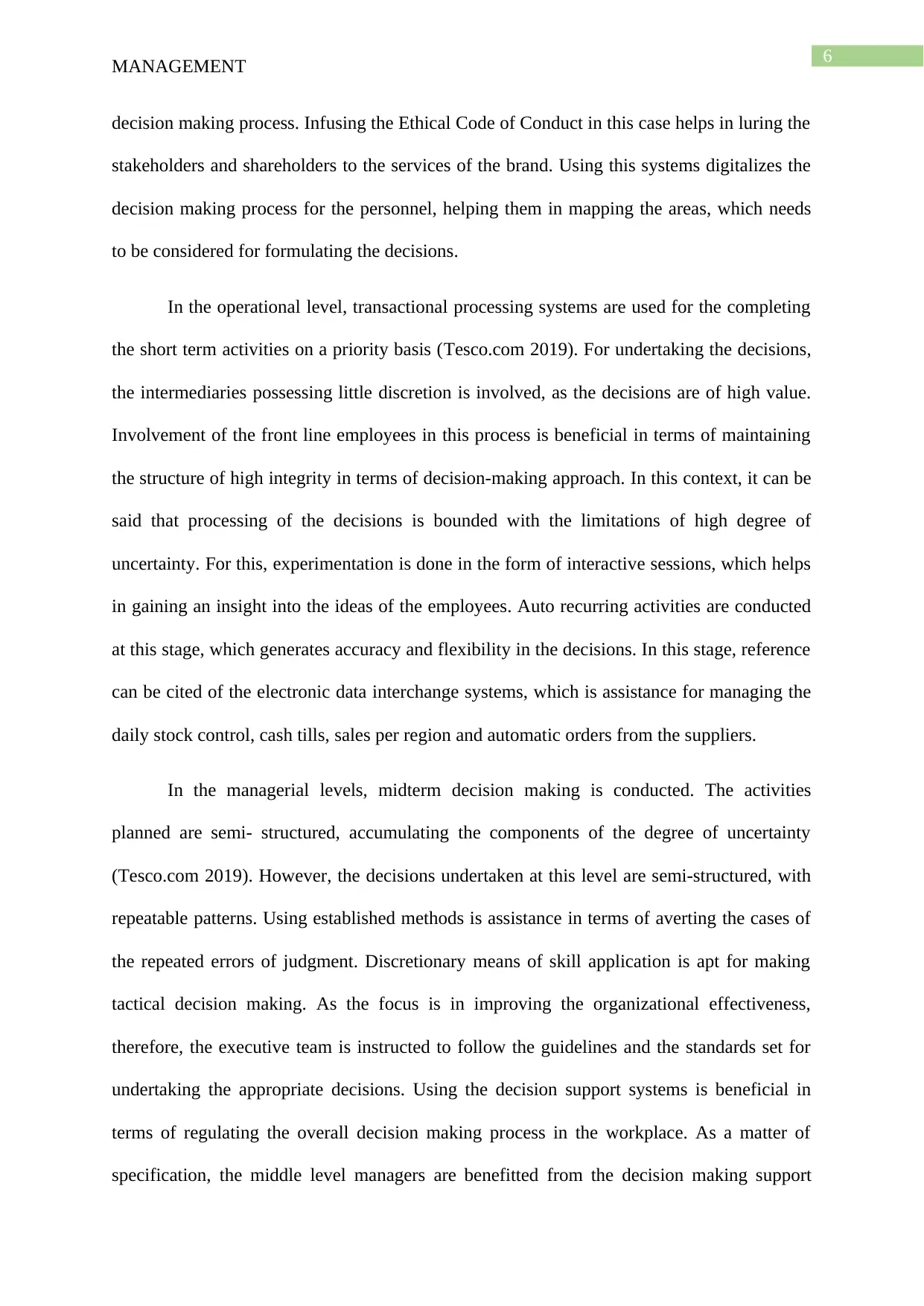
6
MANAGEMENT
decision making process. Infusing the Ethical Code of Conduct in this case helps in luring the
stakeholders and shareholders to the services of the brand. Using this systems digitalizes the
decision making process for the personnel, helping them in mapping the areas, which needs
to be considered for formulating the decisions.
In the operational level, transactional processing systems are used for the completing
the short term activities on a priority basis (Tesco.com 2019). For undertaking the decisions,
the intermediaries possessing little discretion is involved, as the decisions are of high value.
Involvement of the front line employees in this process is beneficial in terms of maintaining
the structure of high integrity in terms of decision-making approach. In this context, it can be
said that processing of the decisions is bounded with the limitations of high degree of
uncertainty. For this, experimentation is done in the form of interactive sessions, which helps
in gaining an insight into the ideas of the employees. Auto recurring activities are conducted
at this stage, which generates accuracy and flexibility in the decisions. In this stage, reference
can be cited of the electronic data interchange systems, which is assistance for managing the
daily stock control, cash tills, sales per region and automatic orders from the suppliers.
In the managerial levels, midterm decision making is conducted. The activities
planned are semi- structured, accumulating the components of the degree of uncertainty
(Tesco.com 2019). However, the decisions undertaken at this level are semi-structured, with
repeatable patterns. Using established methods is assistance in terms of averting the cases of
the repeated errors of judgment. Discretionary means of skill application is apt for making
tactical decision making. As the focus is in improving the organizational effectiveness,
therefore, the executive team is instructed to follow the guidelines and the standards set for
undertaking the appropriate decisions. Using the decision support systems is beneficial in
terms of regulating the overall decision making process in the workplace. As a matter of
specification, the middle level managers are benefitted from the decision making support
MANAGEMENT
decision making process. Infusing the Ethical Code of Conduct in this case helps in luring the
stakeholders and shareholders to the services of the brand. Using this systems digitalizes the
decision making process for the personnel, helping them in mapping the areas, which needs
to be considered for formulating the decisions.
In the operational level, transactional processing systems are used for the completing
the short term activities on a priority basis (Tesco.com 2019). For undertaking the decisions,
the intermediaries possessing little discretion is involved, as the decisions are of high value.
Involvement of the front line employees in this process is beneficial in terms of maintaining
the structure of high integrity in terms of decision-making approach. In this context, it can be
said that processing of the decisions is bounded with the limitations of high degree of
uncertainty. For this, experimentation is done in the form of interactive sessions, which helps
in gaining an insight into the ideas of the employees. Auto recurring activities are conducted
at this stage, which generates accuracy and flexibility in the decisions. In this stage, reference
can be cited of the electronic data interchange systems, which is assistance for managing the
daily stock control, cash tills, sales per region and automatic orders from the suppliers.
In the managerial levels, midterm decision making is conducted. The activities
planned are semi- structured, accumulating the components of the degree of uncertainty
(Tesco.com 2019). However, the decisions undertaken at this level are semi-structured, with
repeatable patterns. Using established methods is assistance in terms of averting the cases of
the repeated errors of judgment. Discretionary means of skill application is apt for making
tactical decision making. As the focus is in improving the organizational effectiveness,
therefore, the executive team is instructed to follow the guidelines and the standards set for
undertaking the appropriate decisions. Using the decision support systems is beneficial in
terms of regulating the overall decision making process in the workplace. As a matter of
specification, the middle level managers are benefitted from the decision making support
Paraphrase This Document
Need a fresh take? Get an instant paraphrase of this document with our AI Paraphraser
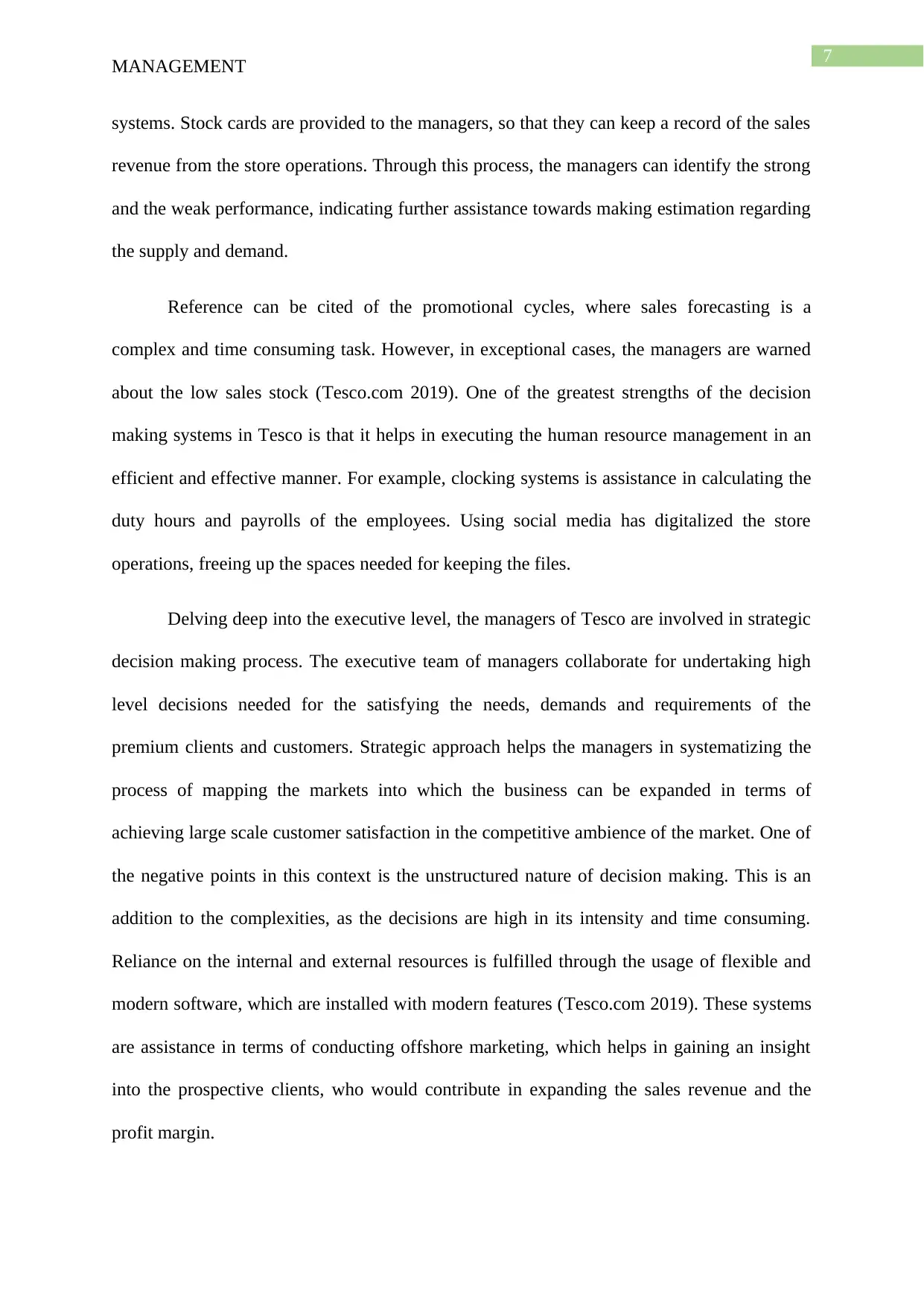
7
MANAGEMENT
systems. Stock cards are provided to the managers, so that they can keep a record of the sales
revenue from the store operations. Through this process, the managers can identify the strong
and the weak performance, indicating further assistance towards making estimation regarding
the supply and demand.
Reference can be cited of the promotional cycles, where sales forecasting is a
complex and time consuming task. However, in exceptional cases, the managers are warned
about the low sales stock (Tesco.com 2019). One of the greatest strengths of the decision
making systems in Tesco is that it helps in executing the human resource management in an
efficient and effective manner. For example, clocking systems is assistance in calculating the
duty hours and payrolls of the employees. Using social media has digitalized the store
operations, freeing up the spaces needed for keeping the files.
Delving deep into the executive level, the managers of Tesco are involved in strategic
decision making process. The executive team of managers collaborate for undertaking high
level decisions needed for the satisfying the needs, demands and requirements of the
premium clients and customers. Strategic approach helps the managers in systematizing the
process of mapping the markets into which the business can be expanded in terms of
achieving large scale customer satisfaction in the competitive ambience of the market. One of
the negative points in this context is the unstructured nature of decision making. This is an
addition to the complexities, as the decisions are high in its intensity and time consuming.
Reliance on the internal and external resources is fulfilled through the usage of flexible and
modern software, which are installed with modern features (Tesco.com 2019). These systems
are assistance in terms of conducting offshore marketing, which helps in gaining an insight
into the prospective clients, who would contribute in expanding the sales revenue and the
profit margin.
MANAGEMENT
systems. Stock cards are provided to the managers, so that they can keep a record of the sales
revenue from the store operations. Through this process, the managers can identify the strong
and the weak performance, indicating further assistance towards making estimation regarding
the supply and demand.
Reference can be cited of the promotional cycles, where sales forecasting is a
complex and time consuming task. However, in exceptional cases, the managers are warned
about the low sales stock (Tesco.com 2019). One of the greatest strengths of the decision
making systems in Tesco is that it helps in executing the human resource management in an
efficient and effective manner. For example, clocking systems is assistance in calculating the
duty hours and payrolls of the employees. Using social media has digitalized the store
operations, freeing up the spaces needed for keeping the files.
Delving deep into the executive level, the managers of Tesco are involved in strategic
decision making process. The executive team of managers collaborate for undertaking high
level decisions needed for the satisfying the needs, demands and requirements of the
premium clients and customers. Strategic approach helps the managers in systematizing the
process of mapping the markets into which the business can be expanded in terms of
achieving large scale customer satisfaction in the competitive ambience of the market. One of
the negative points in this context is the unstructured nature of decision making. This is an
addition to the complexities, as the decisions are high in its intensity and time consuming.
Reliance on the internal and external resources is fulfilled through the usage of flexible and
modern software, which are installed with modern features (Tesco.com 2019). These systems
are assistance in terms of conducting offshore marketing, which helps in gaining an insight
into the prospective clients, who would contribute in expanding the sales revenue and the
profit margin.
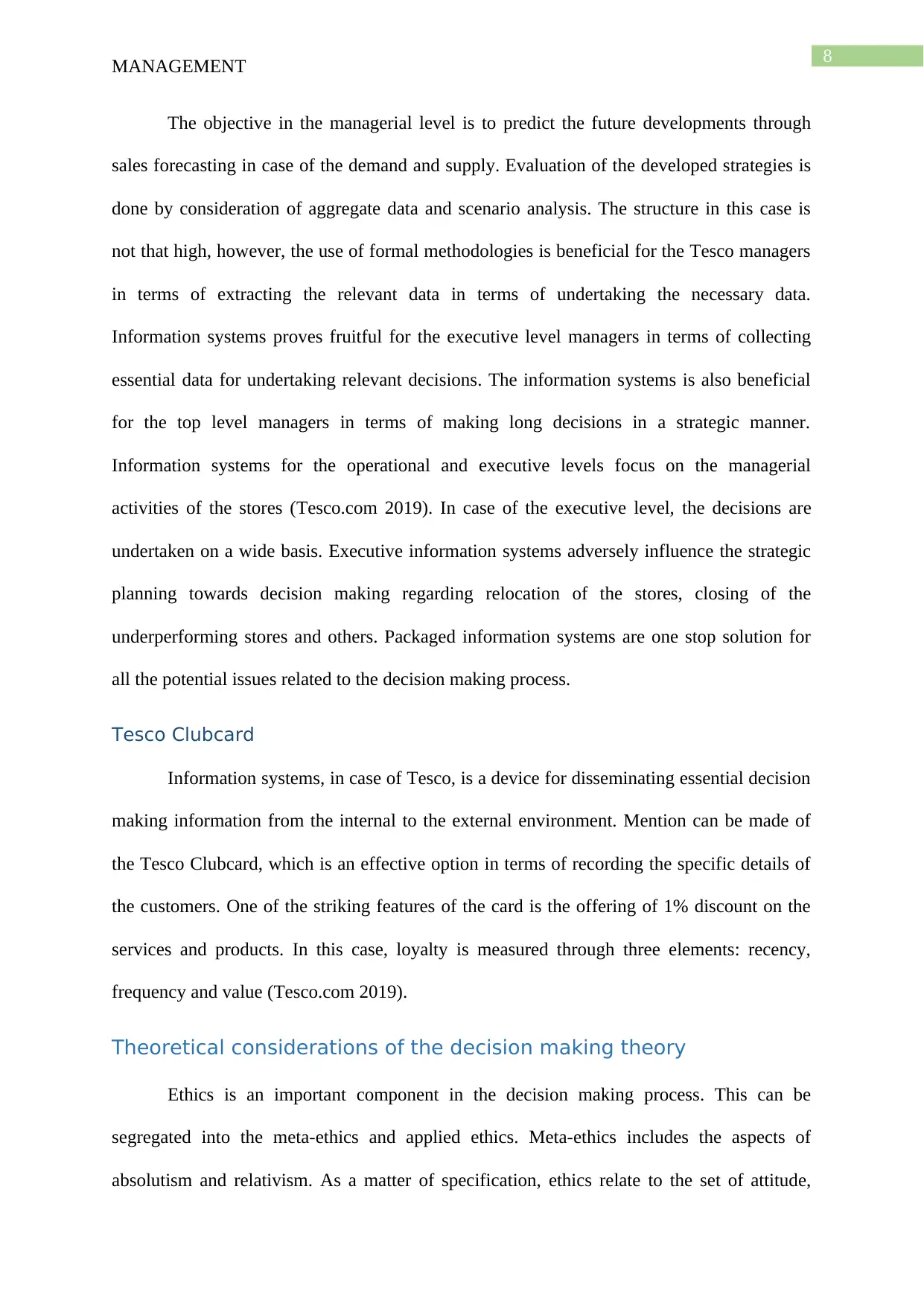
8
MANAGEMENT
The objective in the managerial level is to predict the future developments through
sales forecasting in case of the demand and supply. Evaluation of the developed strategies is
done by consideration of aggregate data and scenario analysis. The structure in this case is
not that high, however, the use of formal methodologies is beneficial for the Tesco managers
in terms of extracting the relevant data in terms of undertaking the necessary data.
Information systems proves fruitful for the executive level managers in terms of collecting
essential data for undertaking relevant decisions. The information systems is also beneficial
for the top level managers in terms of making long decisions in a strategic manner.
Information systems for the operational and executive levels focus on the managerial
activities of the stores (Tesco.com 2019). In case of the executive level, the decisions are
undertaken on a wide basis. Executive information systems adversely influence the strategic
planning towards decision making regarding relocation of the stores, closing of the
underperforming stores and others. Packaged information systems are one stop solution for
all the potential issues related to the decision making process.
Tesco Clubcard
Information systems, in case of Tesco, is a device for disseminating essential decision
making information from the internal to the external environment. Mention can be made of
the Tesco Clubcard, which is an effective option in terms of recording the specific details of
the customers. One of the striking features of the card is the offering of 1% discount on the
services and products. In this case, loyalty is measured through three elements: recency,
frequency and value (Tesco.com 2019).
Theoretical considerations of the decision making theory
Ethics is an important component in the decision making process. This can be
segregated into the meta-ethics and applied ethics. Meta-ethics includes the aspects of
absolutism and relativism. As a matter of specification, ethics relate to the set of attitude,
MANAGEMENT
The objective in the managerial level is to predict the future developments through
sales forecasting in case of the demand and supply. Evaluation of the developed strategies is
done by consideration of aggregate data and scenario analysis. The structure in this case is
not that high, however, the use of formal methodologies is beneficial for the Tesco managers
in terms of extracting the relevant data in terms of undertaking the necessary data.
Information systems proves fruitful for the executive level managers in terms of collecting
essential data for undertaking relevant decisions. The information systems is also beneficial
for the top level managers in terms of making long decisions in a strategic manner.
Information systems for the operational and executive levels focus on the managerial
activities of the stores (Tesco.com 2019). In case of the executive level, the decisions are
undertaken on a wide basis. Executive information systems adversely influence the strategic
planning towards decision making regarding relocation of the stores, closing of the
underperforming stores and others. Packaged information systems are one stop solution for
all the potential issues related to the decision making process.
Tesco Clubcard
Information systems, in case of Tesco, is a device for disseminating essential decision
making information from the internal to the external environment. Mention can be made of
the Tesco Clubcard, which is an effective option in terms of recording the specific details of
the customers. One of the striking features of the card is the offering of 1% discount on the
services and products. In this case, loyalty is measured through three elements: recency,
frequency and value (Tesco.com 2019).
Theoretical considerations of the decision making theory
Ethics is an important component in the decision making process. This can be
segregated into the meta-ethics and applied ethics. Meta-ethics includes the aspects of
absolutism and relativism. As a matter of specification, ethics relate to the set of attitude,
⊘ This is a preview!⊘
Do you want full access?
Subscribe today to unlock all pages.

Trusted by 1+ million students worldwide
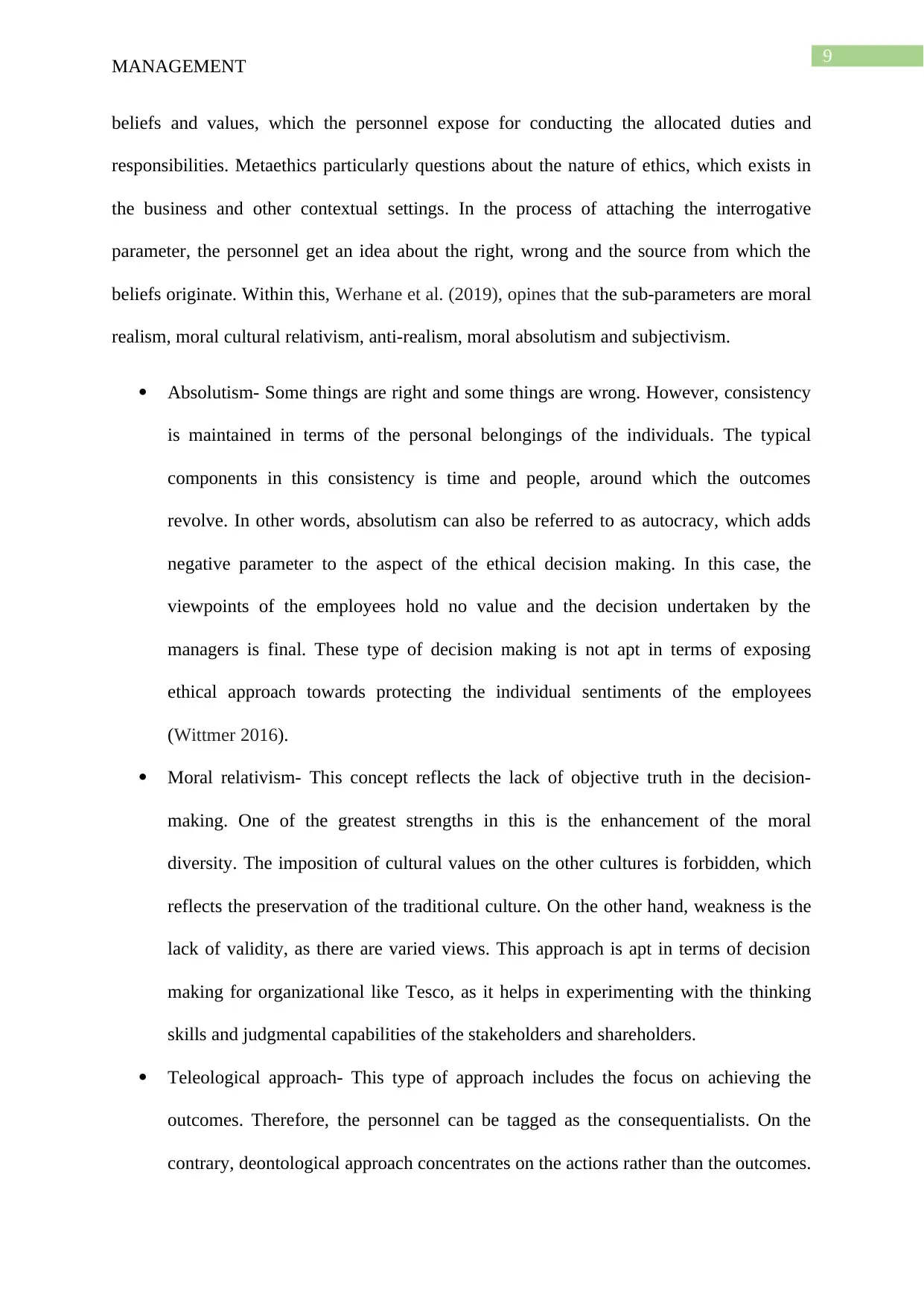
9
MANAGEMENT
beliefs and values, which the personnel expose for conducting the allocated duties and
responsibilities. Metaethics particularly questions about the nature of ethics, which exists in
the business and other contextual settings. In the process of attaching the interrogative
parameter, the personnel get an idea about the right, wrong and the source from which the
beliefs originate. Within this, Werhane et al. (2019), opines that the sub-parameters are moral
realism, moral cultural relativism, anti-realism, moral absolutism and subjectivism.
Absolutism- Some things are right and some things are wrong. However, consistency
is maintained in terms of the personal belongings of the individuals. The typical
components in this consistency is time and people, around which the outcomes
revolve. In other words, absolutism can also be referred to as autocracy, which adds
negative parameter to the aspect of the ethical decision making. In this case, the
viewpoints of the employees hold no value and the decision undertaken by the
managers is final. These type of decision making is not apt in terms of exposing
ethical approach towards protecting the individual sentiments of the employees
(Wittmer 2016).
Moral relativism- This concept reflects the lack of objective truth in the decision-
making. One of the greatest strengths in this is the enhancement of the moral
diversity. The imposition of cultural values on the other cultures is forbidden, which
reflects the preservation of the traditional culture. On the other hand, weakness is the
lack of validity, as there are varied views. This approach is apt in terms of decision
making for organizational like Tesco, as it helps in experimenting with the thinking
skills and judgmental capabilities of the stakeholders and shareholders.
Teleological approach- This type of approach includes the focus on achieving the
outcomes. Therefore, the personnel can be tagged as the consequentialists. On the
contrary, deontological approach concentrates on the actions rather than the outcomes.
MANAGEMENT
beliefs and values, which the personnel expose for conducting the allocated duties and
responsibilities. Metaethics particularly questions about the nature of ethics, which exists in
the business and other contextual settings. In the process of attaching the interrogative
parameter, the personnel get an idea about the right, wrong and the source from which the
beliefs originate. Within this, Werhane et al. (2019), opines that the sub-parameters are moral
realism, moral cultural relativism, anti-realism, moral absolutism and subjectivism.
Absolutism- Some things are right and some things are wrong. However, consistency
is maintained in terms of the personal belongings of the individuals. The typical
components in this consistency is time and people, around which the outcomes
revolve. In other words, absolutism can also be referred to as autocracy, which adds
negative parameter to the aspect of the ethical decision making. In this case, the
viewpoints of the employees hold no value and the decision undertaken by the
managers is final. These type of decision making is not apt in terms of exposing
ethical approach towards protecting the individual sentiments of the employees
(Wittmer 2016).
Moral relativism- This concept reflects the lack of objective truth in the decision-
making. One of the greatest strengths in this is the enhancement of the moral
diversity. The imposition of cultural values on the other cultures is forbidden, which
reflects the preservation of the traditional culture. On the other hand, weakness is the
lack of validity, as there are varied views. This approach is apt in terms of decision
making for organizational like Tesco, as it helps in experimenting with the thinking
skills and judgmental capabilities of the stakeholders and shareholders.
Teleological approach- This type of approach includes the focus on achieving the
outcomes. Therefore, the personnel can be tagged as the consequentialists. On the
contrary, deontological approach concentrates on the actions rather than the outcomes.
Paraphrase This Document
Need a fresh take? Get an instant paraphrase of this document with our AI Paraphraser
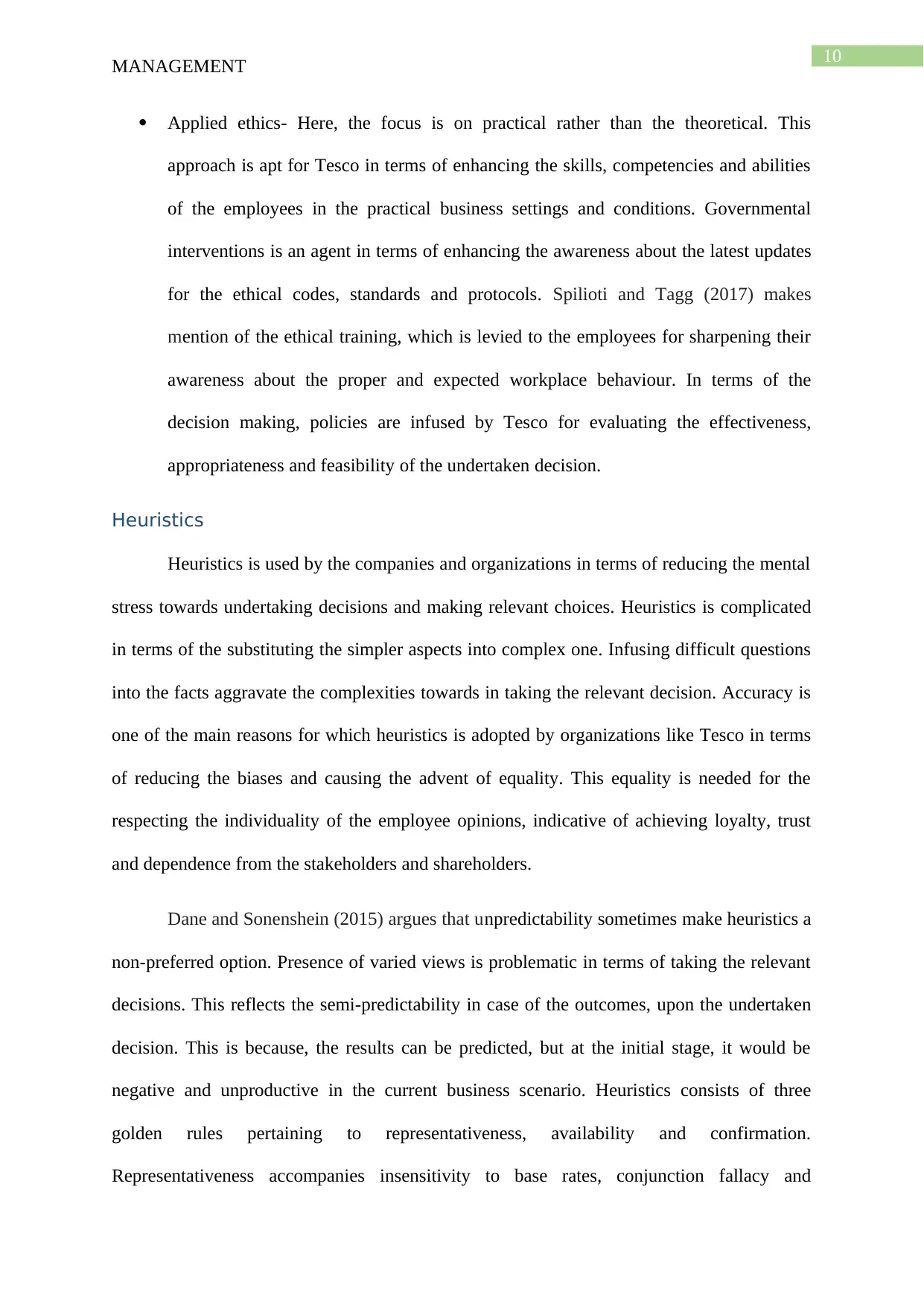
10
MANAGEMENT
Applied ethics- Here, the focus is on practical rather than the theoretical. This
approach is apt for Tesco in terms of enhancing the skills, competencies and abilities
of the employees in the practical business settings and conditions. Governmental
interventions is an agent in terms of enhancing the awareness about the latest updates
for the ethical codes, standards and protocols. Spilioti and Tagg (2017) makes
mention of the ethical training, which is levied to the employees for sharpening their
awareness about the proper and expected workplace behaviour. In terms of the
decision making, policies are infused by Tesco for evaluating the effectiveness,
appropriateness and feasibility of the undertaken decision.
Heuristics
Heuristics is used by the companies and organizations in terms of reducing the mental
stress towards undertaking decisions and making relevant choices. Heuristics is complicated
in terms of the substituting the simpler aspects into complex one. Infusing difficult questions
into the facts aggravate the complexities towards in taking the relevant decision. Accuracy is
one of the main reasons for which heuristics is adopted by organizations like Tesco in terms
of reducing the biases and causing the advent of equality. This equality is needed for the
respecting the individuality of the employee opinions, indicative of achieving loyalty, trust
and dependence from the stakeholders and shareholders.
Dane and Sonenshein (2015) argues that unpredictability sometimes make heuristics a
non-preferred option. Presence of varied views is problematic in terms of taking the relevant
decisions. This reflects the semi-predictability in case of the outcomes, upon the undertaken
decision. This is because, the results can be predicted, but at the initial stage, it would be
negative and unproductive in the current business scenario. Heuristics consists of three
golden rules pertaining to representativeness, availability and confirmation.
Representativeness accompanies insensitivity to base rates, conjunction fallacy and
MANAGEMENT
Applied ethics- Here, the focus is on practical rather than the theoretical. This
approach is apt for Tesco in terms of enhancing the skills, competencies and abilities
of the employees in the practical business settings and conditions. Governmental
interventions is an agent in terms of enhancing the awareness about the latest updates
for the ethical codes, standards and protocols. Spilioti and Tagg (2017) makes
mention of the ethical training, which is levied to the employees for sharpening their
awareness about the proper and expected workplace behaviour. In terms of the
decision making, policies are infused by Tesco for evaluating the effectiveness,
appropriateness and feasibility of the undertaken decision.
Heuristics
Heuristics is used by the companies and organizations in terms of reducing the mental
stress towards undertaking decisions and making relevant choices. Heuristics is complicated
in terms of the substituting the simpler aspects into complex one. Infusing difficult questions
into the facts aggravate the complexities towards in taking the relevant decision. Accuracy is
one of the main reasons for which heuristics is adopted by organizations like Tesco in terms
of reducing the biases and causing the advent of equality. This equality is needed for the
respecting the individuality of the employee opinions, indicative of achieving loyalty, trust
and dependence from the stakeholders and shareholders.
Dane and Sonenshein (2015) argues that unpredictability sometimes make heuristics a
non-preferred option. Presence of varied views is problematic in terms of taking the relevant
decisions. This reflects the semi-predictability in case of the outcomes, upon the undertaken
decision. This is because, the results can be predicted, but at the initial stage, it would be
negative and unproductive in the current business scenario. Heuristics consists of three
golden rules pertaining to representativeness, availability and confirmation.
Representativeness accompanies insensitivity to base rates, conjunction fallacy and
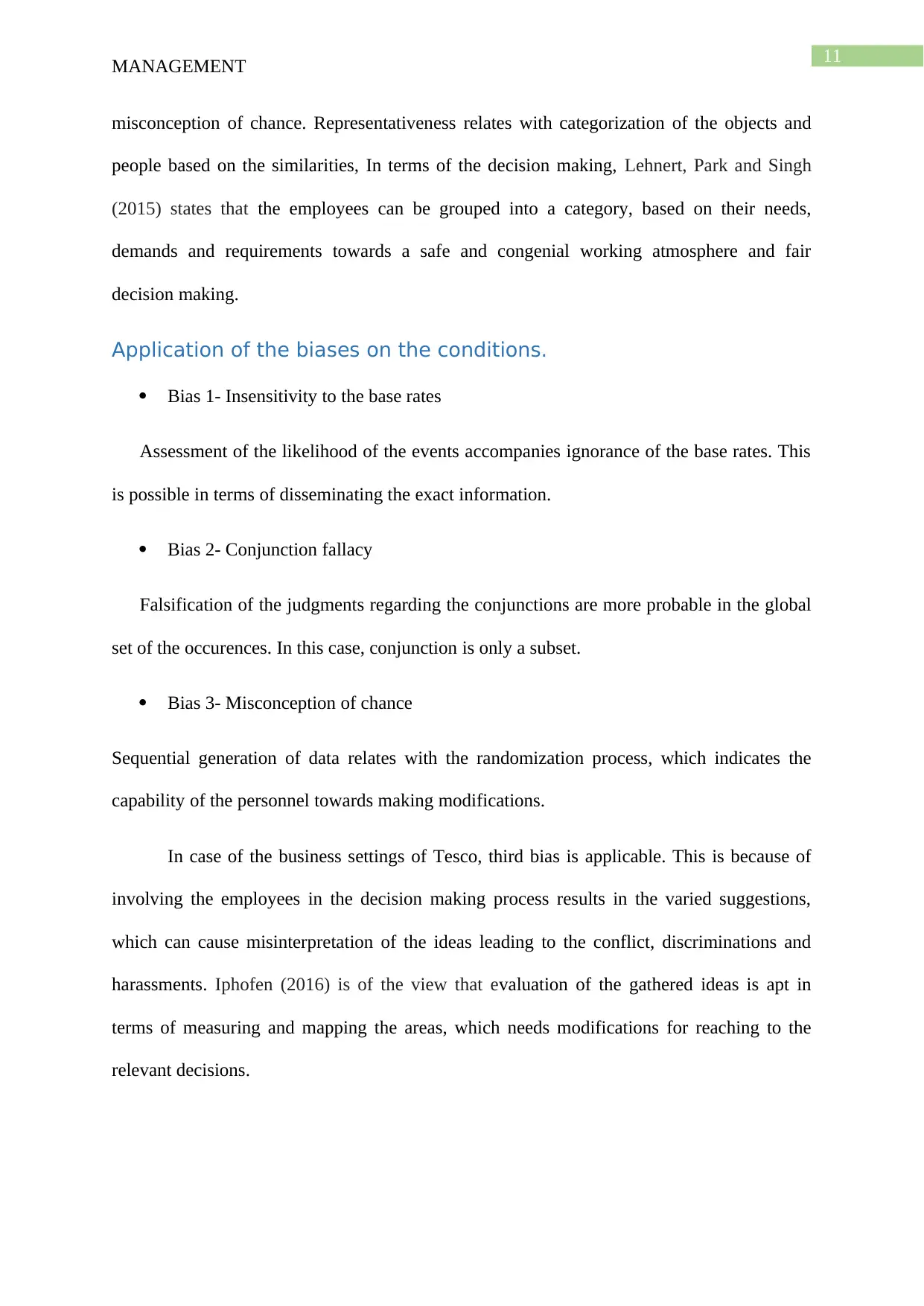
11
MANAGEMENT
misconception of chance. Representativeness relates with categorization of the objects and
people based on the similarities, In terms of the decision making, Lehnert, Park and Singh
(2015) states that the employees can be grouped into a category, based on their needs,
demands and requirements towards a safe and congenial working atmosphere and fair
decision making.
Application of the biases on the conditions.
Bias 1- Insensitivity to the base rates
Assessment of the likelihood of the events accompanies ignorance of the base rates. This
is possible in terms of disseminating the exact information.
Bias 2- Conjunction fallacy
Falsification of the judgments regarding the conjunctions are more probable in the global
set of the occurences. In this case, conjunction is only a subset.
Bias 3- Misconception of chance
Sequential generation of data relates with the randomization process, which indicates the
capability of the personnel towards making modifications.
In case of the business settings of Tesco, third bias is applicable. This is because of
involving the employees in the decision making process results in the varied suggestions,
which can cause misinterpretation of the ideas leading to the conflict, discriminations and
harassments. Iphofen (2016) is of the view that evaluation of the gathered ideas is apt in
terms of measuring and mapping the areas, which needs modifications for reaching to the
relevant decisions.
MANAGEMENT
misconception of chance. Representativeness relates with categorization of the objects and
people based on the similarities, In terms of the decision making, Lehnert, Park and Singh
(2015) states that the employees can be grouped into a category, based on their needs,
demands and requirements towards a safe and congenial working atmosphere and fair
decision making.
Application of the biases on the conditions.
Bias 1- Insensitivity to the base rates
Assessment of the likelihood of the events accompanies ignorance of the base rates. This
is possible in terms of disseminating the exact information.
Bias 2- Conjunction fallacy
Falsification of the judgments regarding the conjunctions are more probable in the global
set of the occurences. In this case, conjunction is only a subset.
Bias 3- Misconception of chance
Sequential generation of data relates with the randomization process, which indicates the
capability of the personnel towards making modifications.
In case of the business settings of Tesco, third bias is applicable. This is because of
involving the employees in the decision making process results in the varied suggestions,
which can cause misinterpretation of the ideas leading to the conflict, discriminations and
harassments. Iphofen (2016) is of the view that evaluation of the gathered ideas is apt in
terms of measuring and mapping the areas, which needs modifications for reaching to the
relevant decisions.
⊘ This is a preview!⊘
Do you want full access?
Subscribe today to unlock all pages.

Trusted by 1+ million students worldwide
1 out of 19
Related Documents
Your All-in-One AI-Powered Toolkit for Academic Success.
+13062052269
info@desklib.com
Available 24*7 on WhatsApp / Email
![[object Object]](/_next/static/media/star-bottom.7253800d.svg)
Unlock your academic potential
Copyright © 2020–2025 A2Z Services. All Rights Reserved. Developed and managed by ZUCOL.




